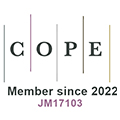REFERENCES
1. Fitzek, F. H. P.; Li, S. C.; Speidel, S.; Strufe, T.; Seeling, P. Frontiers of transdisciplinary research in Tactile Internet with human-in-the-loop. In 2021 17th International Symposium on Wireless Communication Systems (ISWCS), Berlin, Germany. Sep 06-09, 2021. IEEE; 2021. p. 1-6.
2. Lipomi, D. J.; Dhong, C.; Carpenter, C. W.; Root, N. B.; Ramachandran, V. S. Organic haptics: intersection of materials chemistry and tactile perception. Adv. Funct. Mater. 2020, 30, 1906850.
3. Yang, J.; Liu, S.; Meng, Y.; et al. Self-powered tactile sensor for gesture recognition using deep learning algorithms. ACS. Appl. Mater. Interfaces. 2022, 14, 25629-37.
4. Li, R.; Adelson, E. H. Sensing and recognizing surface textures using a GelSight sensor. In 2013 IEEE Conference on Computer Vision and Pattern Recognition, Portland, USA. Jun 23-28, 2013. IEEE; 2013. pp. 1241-7.
5. Olugbade, T.; He, L.; Maiolino, P.; Heylen, D.; Bianchi-Berthouze, N. Touch technology in affective human-, robot-, and virtual-human interactions: a survey. Proc. IEEE. 2023, 111, 1333-54.
6. Di Stefano, N.; Spence, C. Roughness perception: a multisensory/crossmodal perspective. Atten. Percept. Psychophys. 2022, 84, 2087-114.
7. Sathian, K.; Lacey, S. Cross-modal interactions of the tactile system. Curr. Dir. Psychol. Sci. 2022, 31, 411-8.
8. Chen, S.; Ge, S.; Tang, W.; Zhang, J.; Chen, N. Tactile perception of fabrics with an artificial finger compared to human sensing. Text. Res. J. 2015, 85, 2177-87.
9. Mostafavi Yazdi, S. J.; Baqersad, J. Mechanical modeling and characterization of human skin: a review. J. Biomech. 2022, 130, 110864.
10. Kirby, M. A.; Tang, P.; Liou, H. C.; et al. Probing elastic anisotropy of human skin in vivo with light using non-contact acoustic micro-tapping OCE and polarization sensitive OCT. Sci. Rep. 2022, 12, 3963.
11. Infante, V. H. P.; Fehlberg, M.; Saikumar, S.; Drewing, K.; Meinke, M. C.; Bennewitz, R. The role of skin hydration, skin deformability, and age in tactile friction and perception of materials. Sci. Rep. 2025, 15, 9935.
12. Coste, B.; Mathur, J.; Schmidt, M.; et al. Piezo1 and Piezo2 are essential components of distinct mechanically activated cation channels. Science 2010, 330, 55-60.
13. Douguet, D.; Honoré, E. Mammalian mechanoelectrical transduction: structure and function of force-gated ion channels. Cell 2019, 179, 340-54.
14. Bochereau, S. Perception, recording and reproduction of physical invariants during bare fingertip exploration of tactile textures. 2017. https://theses.hal.science/tel-01609838v1. (accessed 26 Jun 2025).
15. Henderson, J. An investigation of the neural basis of texture processing during active touch. 2023. https://www.proquest.com/openview/3c3a3d045a93675055c053ec6393644d/1?pq-origsite=gscholar&cbl=2026366&diss=y. (accessed 26 Jun 2025).
16. Kuroki, S.; Sawayama, M.; Nishida, S. The roles of lower- and higher-order surface statistics in tactile texture perception. J. Neurophysiol. 2021, 126, 95-111.
17. Chen, H.; Fu, S.; Zhi, X.; et al. Research progress on neural processing of hand and forearm tactile sensation: a review based on fMRI research. Neuropsychiatr. Dis. Treat. 2025, 21, 193-212.
18. Liu, Z.; Kim, J. T.; Rogers, J. A.; Klatzky, R. L.; Colgate, J. E. Realism of tactile texture playback: a combination of stretch and vibration. IEEE. Trans. Haptics. 2024, 17, 441-50.
19. See, A. R.; Choco, J. A. G.; Chandramohan, K. Touch, texture and haptic feedback: a review on how we feel the world around us. Appl. Sci. 2022, 12, 4686.
20. Yin, F.; Niu, H.; Kim, E.; Shin, Y. K.; Li, Y.; Kim, N. Advanced polymer materials-based electronic skins for tactile and non-contact sensing applications. InfoMat 2023, 5, e12424.
21. Fan, L.; Song, A.; Zhang, H. Haptic interface device using cable tension based on ultrasonic phased array. IEEE. Access. 2020, 8, 162880-91.
22. Kumar, A.; Kempski Leadingham, K. M.; Kerensky, M. J.; Sankar, S.; Thakor, N. V.; Manbachi, A. Visualizing tactile feedback: an overview of current technologies with a focus on ultrasound elastography. Front. Med. Technol. 2023, 5, 1238129.
23. Hecht, D.; Reiner, M. Sensory dominance in combinations of audio, visual and haptic stimuli. Exp. Brain. Res. 2009, 193, 307-14.
24. Boban, L.; Pittet, D.; Herbelin, B.; Boulic, R. Changing finger movement perception: influence of active haptics on visual dominance. Front. Virtual. Real. 2022, 3, 860872.
25. Friedrich, J.; Beste, C. The impact of stimulus modality on the processing of conflicting sensory information during response inhibition. Neuroscience 2019, 410, 191-201.
26. Jagt, M.; Ganis, F.; Serafin, S. Enhanced neural phase locking through audio-tactile stimulation. Front. Neurosci. 2024, 18, 1425398.
27. Li, Z.; Li, Z.; Tang, W.; et al. Crossmodal sensory neurons based on high-performance flexible memristors for human-machine in-sensor computing system. Nat. Commun. 2024, 15, 7275.
28. Strese, M.; Brudermueller, L.; Kirsch, J.; Steinbach, E. Haptic material analysis and classification inspired by human exploratory procedures. IEEE. Trans. Haptics. 2020, 13, 404-24.
29. Adilkhanov, A.; Rubagotti, M.; Kappassov, Z. Haptic devices: wearability-based taxonomy and literature review. IEEE. Access. 2022, 10, 91923-47.
30. Biswas, S.; Visell, Y. Haptic perception, mechanics, and material technologies for virtual reality. Adv. Funct. Mater. 2021, 31, 2008186.
31. Pestell, N.; Lepora, N. F. Artificial SA-I, RA-I and RA-II/vibrotactile afferents for tactile sensing of texture. J. R. Soc. Interface. 2022, 19, 20210603.
32. Kim, S.; Lee, D. Y. Introduction to haptic systems. control design for haptic systems. Singapore: Springer Nature; 2024. pp. 1-11.
33. Basdogan, C.; Giraud, F.; Levesque, V.; Choi, S. A review of surface haptics: enabling tactile effects on touch surfaces. IEEE. Trans. Haptics. 2020, 13, 450-70.
34. Jung, Y.; Ramos, J. A large force haptic interface with modular linear actuators. Actuators 2023, 12, 293.
35. Zhu, M.; Biswas, S.; Dinulescu, S. I.; Kastor, N.; Hawkes, E. W.; Visell, Y. Soft, wearable robotics and haptics: technologies, trends, and emerging applications. Proc. IEEE. 2022, 110, 246-72.
36. Chen, K.; Li, T.; Yan, T.; et al. A soft gripper design for apple harvesting with force feedback and fruit slip detection. Agriculture 2022, 12, 1802.
37. Hong, W.; Guo, X.; Li, X.; et al. Fishbone and nettle fiber inspired stretchable strain sensor with high sensitivity and wide sensing range for wearable electronics. Chem. Eng. J. 2024, 492, 152281.
38. Chen, S.; Chen, Y.; Yang, J.; Han, T.; Yao, S. Skin-integrated stretchable actuators toward skin-compatible haptic feedback and closed-loop human-machine interactions. npj. Flex. Electron. 2023, 7, 235.
39. Suzuki, S.; Fujiwara, M.; Makino, Y.; Shinoda, H. Radiation pressure field reconstruction for ultrasound midair haptics by greedy algorithm with brute-force search. IEEE. Trans. Haptics. 2021, 14, 914-21.
40. Ragolia, M. A.; De Palma, L.; Giaquinto, N.; Pignatelli, A.; Scarpetta, M. Ultrasound haptics for XR and rehabilitation: influence of arm and hand muscle stiffness on user perception. In 2024 IEEE International Conference on Metrology for eXtended Reality, Artificial Intelligence and Neural Engineering (MetroXRAINE), St Albans, UK. Oct 21-23, 2024. IEEE; 2024. pp. 1000-4.
41. Zhang, K.; Liu, Z.; Zhou, Y.; et al. Thin and flexible breeze-sense generators for non-contact haptic feedback in virtual reality. Nanomicro. Lett. 2025, 17, 144.
42. Cao, H. X.; Jung, D.; Lee, H. S.; et al. Holographic acoustic tweezers for 5-DoF manipulation of nanocarrier clusters toward targeted drug delivery. Pharmaceutics 2022, 14, 1490.
43. Hirayama, R.; Martinez Plasencia, D.; Masuda, N.; Subramanian, S. A volumetric display for visual, tactile and audio presentation using acoustic trapping. Nature 2019, 575, 320-3.
44. Gao, Y.; Yao, K.; Jia, S.; et al. Advances in materials for haptic skin electronics. Matter 2024, 7, 2826-45.
45. Zhi, C.; Shi, S.; Wu, H.; et al. Emerging trends of nanofibrous piezoelectric and triboelectric applications: mechanisms, electroactive materials, and designed architectures. Adv. Mater. 2024, 36, e2401264.
46. Chi, X.; Tan, C.; Li, B.; Lu, J.; Gu, C.; Fu, C. Multidisciplinary optimization of electromagnetic linear actuators for direct-drive systems with a combination of static and dynamic performance. COMPEL 2023, 42, 476-93.
47. Singh, N. K. Fabrication, characterization and modeling of electroactive polymer-based strain sensors for wearable applications. 2022. (in Japanese) https://kyutech.repo.nii.ac.jp/records/7811. (accessed 26 Jun 2025).
48. Xiang, H.; Peng, L.; Yang, Q.; Wang, Z. L.; Cao, X. Triboelectric nanogenerator for high-entropy energy, self-powered sensors, and popular education. Sci. Adv. 2024, 10, eads2291.
50. Brahimaj, D. Integrating haptic feedback in smart devices: multimodal interfaces and design guidelines. 2024. https://theses.hal.science/tel-04623701. (accessed 26 Jun 2025).
51. Zhang, M.; Terui, S.; Makino, Y.; Shinoda, H. TexSenseGAN: a user-guided system for optimizing texture-related vibrotactile feedback using generative adversarial network. IEEE. Trans. Haptics. 2025, 18, 325-39.
52. Cai, S.; Zhao, L.; Ban, Y.; Narumi, T.; Liu, Y.; Zhu, K. GAN-based image-to-friction generation for tactile simulation of fabric material. Comput. Graph. 2022, 102, 460-73.
53. Yi, Z.; Zhang, Y.; Peters, J. Biomimetic tactile sensors and signal processing with spike trains: a review. Sens. Actuators. A. Phys. 2018, 269, 41-52.
54. Docquier, N.; Timmermans, S.; Fisette, P. Haptic devices based on real-time dynamic models of multibody systems, Sensors 2021;21:4794.
55. Fang, Y.; Zhang, X.; Xu, W.; Liu, G.; Zhao, J. Bidirectional visual-tactile cross-modal generation using latent feature space flow model. Neural. Netw. 2024, 172, 106088.
56. Aykut, T.; Karimi, M.; Burgmair, C.; Finkenzeller, A.; Bachhuber, C.; Steinbach, E. Delay compensation for a telepresence system with 3D 360 degree vision based on deep head motion prediction and dynamic FoV adaptation. IEEE. Robot. Autom. Lett. 2018, 3, 4343-50.
57. Lei, Y.; Deng, Y.; Dong, L.; Li, X.; Li, X.; Su, Z. A novel sensor fusion approach for precise hand tracking in virtual reality-based human-computer interaction. Biomimetics 2023, 8, 326.
58. Shen, Y.; Pan, Z. Evaluating the impact of immersive virtual reality learning environments with a cognitive load on students in various interaction modes. In 2022 8th International Conference on Virtual Reality (ICVR), Nanjing, China. May 26-28, 2022. IEEE; 2022. pp. 210-5.
59. Webb, M.; Tracey, M.; Harwin, W.; et al. Haptic-enabled collaborative learning in virtual reality for schools. Educ. Inf. Technol. 2022, 27, 937-60.
60. Tanacar, N. T.; Mughrabi, M. H.; Batmaz, A. U.; Leonardis, D.; Sarac, M. The impact of haptic feedback during sudden, rapid virtual interactions. In 2023 IEEE World Haptics Conference (WHC), Delft, Netherlands. Jul 10-13, 2023. IEEE; 2023. pp. 64-70.
61. Brunnström, K.; Dima, E.; Qureshi, T.; Johanson, M.; Andersson, M.; Sjöström, M. Latency impact on Quality of Experience in a virtual reality simulator for remote control of machines. Signal. Process. Image. Commun. 2020, 89, 116005.
62. Raspopovic, S.; Valle, G.; Petrini, F. M. Sensory feedback for limb prostheses in amputees. Nat. Mater. 2021, 20, 925-39.
63. Pasluosta, C.; Kiele, P.; Stieglitz, T. Paradigms for restoration of somatosensory feedback via stimulation of the peripheral nervous system. Clin. Neurophysiol. 2018, 129, 851-62.
64. Weber, D. J.; Hao, M.; Urbin, M. A.; Schoenewald, C.; Lan, N. Chapter Twenty one - Sensory information feedback for neural prostheses. In: Biomedical information technology. Elsevier; 2020. pp. 687-715.
65. Girard, A.; Marchal, M.; Gosselin, F.; Chabrier, A.; Louveau, F.; Lécuyer, A. HapTip: displaying haptic shear forces at the fingertips for multi-finger interaction in virtual environments. Front. ICT. 2016, 3, 6.
66. Kourtesis, P.; Argelaguet, F.; Vizcay, S.; Marchal, M.; Pacchierotti, C. Electrotactile feedback applications for hand and arm interactions: a systematic review, meta-analysis, and future directions. IEEE. Trans. Haptics. 2022, 15, 479-96.
67. Höhler, C.; Trigili, E.; Astarita, D.; Hermsdörfer, J.; Jahn, K.; Krewer, C. The efficacy of hybrid neuroprostheses in the rehabilitation of upper limb impairment after stroke, a narrative and systematic review with a meta-analysis. Artif. Organs. 2024, 48, 232-53.
68. Li, S.; Xu, J. Multiaxis force/torque sensor technologies: design principles and robotic force control applications: a review. IEEE. Sensors. J. 2025, 25, 4055-69.
69. Yi, Z.; Xu, T.; Guo, S.; Shang, W.; Wu, X. Tactile surface roughness categorization with multineuron spike train distance. IEEE. Trans. Automat. Sci. Eng. 2021, 18, 1835-45.
70. Liao, X.; Li, Y.; Hu, J.; et al. Effects of contact method and acclimation on temperature and humidity in touch perception. Text. Res. J. 2018, 88, 1605-15.
71. Filingeri, D.; Fournet, D.; Hodder, S.; Havenith, G. Tactile cues significantly modulate the perception of sweat-induced skin wetness independently of the level of physical skin wetness. J. Neurophysiol. 2015, 113, 3462-73.
72. Jha, S.; Balaji, M.; Peck, J.; Oakley, J.; Deitz, G. D. The effects of environmental haptic cues on consumer perceptions of retailer warmth and competence. J. Retail. 2020, 96, 590-605.
73. Dione, M.; Watkins, R. H.; Aimonetti, J. M.; Jourdain, R.; Ackerley, R. Effects of skin moisturization on various aspects of touch showing differences with age and skin site. Sci. Rep. 2023, 13, 17977.
74. Kirschner, R. J.; Kurdas, A.; Karacan, K.; et al. Towards a reference framework for tactile robot performance and safety benchmarking. In 2021 IEEE/RSJ International Conference on Intelligent Robots and Systems (IROS), Prague, Czech Republic. Sep 27 - Oct 01, 2021. IEEE; 2021. pp. 4290-7.
75. Li, F.; Hiley, J.; Syed, T. M.; Hitchens, C.; Garcia Lopez-Astilleros, M. A region segmentation method to measure multiple features using a tactile scanning probe. Int. J. Comput. Integr. Manuf. 2019, 32, 569-79.
76. Bi, Z.; Miao, Z.; Zhang, B.; Zhang, C. W. The state of the art of testing standards for integrated robotic systems. Robot. Comput. Integr. Manuf. 2020, 63, 101893.
77. Hedge, C.; Powell, G.; Sumner, P. The reliability paradox: why robust cognitive tasks do not produce reliable individual differences. Behav. Res. Methods. 2018, 50, 1166-86.
78. Krishnan, A.; Thiyagarajan, K.; Kodagoda, S.; Bhattacharjee, M. Wearable flexible temperature sensor suite for thermal-tactile perception. IEEE. Sensors. J. 2024, 24, 39736-43.
79. Limbert, G. Mathematical and computational modelling of skin biophysics: a review. Proc. Math. Phys. Eng. Sci. 2017, 473, 20170257.
80. Bai, J.; Peng, J.; Tang, D.; et al. Thermal tactile perception: device, technology, and experiments. Int. J. Cogn. Inform. Nat. Intell. 2021, 15, 1-19.
81. Park, J.; Lee, Y.; Hong, J.; et al. Tactile-direction-sensitive and stretchable electronic skins based on human-skin-inspired interlocked microstructures. ACS. Nano. 2014, 8, 12020-9.
82. Emami, M.; Bayat, A.; Tafazolli, R.; Quddus, A. A survey on haptics: communication, sensing and feedback. IEEE. Commun. Surv. Tutorials. 2025, 27, 2006-50.
83. Dalsgaard, T. S.; Schneider, O. A unified model for haptic experience. ACM. Trans. Comput. Hum. Interact. 2025, 32, 1-38.
84. Raisamo, R.; Salminen, K.; Rantala, J.; Farooq, A.; Ziat, M. Interpersonal haptic communication: review and directions for the future. Int. J. Hum. Comput. Stud. 2022, 166, 102881.
85. Xie, Z.; Zhu, X.; Wang, W.; et al. Temporal pattern coding in ionic memristor-based spiking neurons for adaptive tactile perception. Adv. Elect. Mater. 2022, 8, 2200334.
86. Kumar, S.; Kumar, N.; Tiwari, S.; Sandeep,
87. Xavier, J.; Yu, D.; Jones, C.; Zossimova, E.; Vollmer, F. Quantum nanophotonic and nanoplasmonic sensing: towards quantum optical bioscience laboratories on chip. Nanophotonics 2021, 10, 1387-435.
88. Tafadzwa Mpofu, K.; Mthunzi-Kufa, P. Recent advances in quantum biosensing technologies. In: Current developments in biosensor applications and smart strategies [Working Title]. IntechOpen; 2025.
89. Maclean, K. E.; Schneider, O. S.; Seifi, H. Multisensory haptic interactions: understanding the sense and designing for it. In: The Handbook of multimodal-multisensor interfaces, Volume 1; 2017. pp. 97-142.
90. Cornelio, P.; Velasco, C.; Obrist, M. Multisensory integration as per technological advances: a review. Front. Neurosci. 2021, 15, 652611.
91. Graczyk, E. L.; Schiefer, M. A.; Saal, H. P.; Delhaye, B. P.; Bensmaia, S. J.; Tyler, D. J. The neural basis of perceived intensity in natural and artificial touch. Sci. Transl. Med. 2016, 8, 362ra142.
92. Parianen Lesemann, F. H.; Reuter, E. M.; Godde, B. Tactile stimulation interventions: influence of stimulation parameters on sensorimotor behavior and neurophysiological correlates in healthy and clinical samples. Neurosci. Biobehav. Rev. 2015, 51, 126-37.
93. Mcdaniel, T.; Panchanathan, S. Therapeutic haptics for mental health and wellbeing. In: Mcdaniel T, Panchanathan S, editors. Haptic interfaces for accessibility, health, and enhanced quality of life. Cham: Springer International Publishing; 2020. pp. 149-81.
94. Hajas, D. Ultrasonic mid-air haptic technology in context of science communication, 2021. https://sussex.figshare.com/articles/thesis/Ultrasonic_mid-air_haptic_technology_in_context_of_science_communication/23481617?file=41190560. (accessed 26 Jun 2025).
95. Ninu, A.; Dosen, S.; Farina, D.; Rattay, F.; Dietl, H. A novel wearable vibro-tactile haptic device. In 2013 IEEE International Conference on Consumer Electronics (ICCE), Las Vegas, USA. Jan 11-14, 2013. IEEE; 2013. pp. 51-2.
96. Ley, M.; Rambukkana, N. Touching at a distance: digital intimacies, haptic platforms, and the ethics of consent. Sci. Eng. Ethics. 2021, 27, 63.









